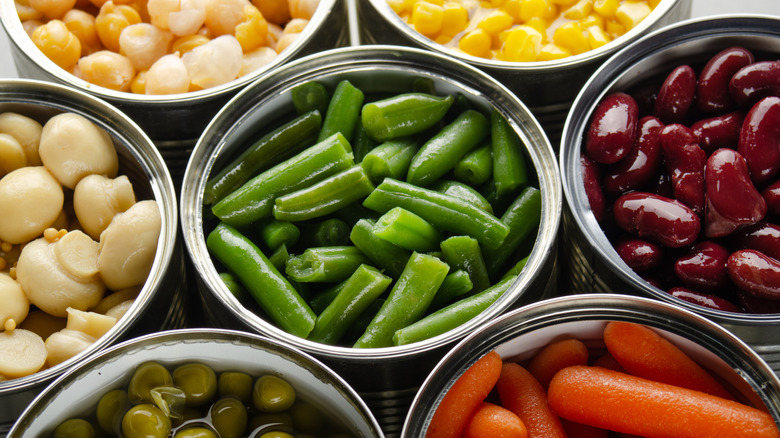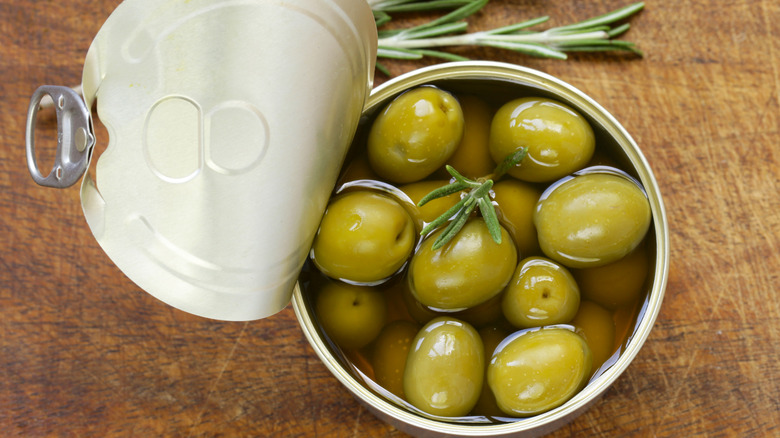6 Canned Ingredients You Should Buy And 4 You Should Avoid, According To Chefs
Canned ingredients are often looked down on, but there's really no need to hate on them. More often than not, they are affordable, easy to store, with long shelf lives, can be elevated with a few extra ingredients, and are available when you're in a pinch.
Canned staples like beans or tomatoes are undeniable lifesavers on busy nights when chopping, cleaning, and sautéing just aren't happening. But let's be real, not every canned ingredient is worth that precious shelf space. The secret? Knowing which cans to stock up on and which to leave alone. To settle any doubt, we asked some of the world's top chefs, chef Glenn Rolnick of Carmine's, T.V. host and New York Times Bestselling author Kardea Brown, chef Michael Symon, chef Michael White, chef JJ Johnson, celebrity chef Geoffrey Zakarian, chef José Andrés, and chef Alon Shaya, to spill on their canned-food dos and don'ts at the 2025 Nassau Paradise Island Wine & Food Festival, and they didn't hold back. So, whether you're stocking up for emergency meals or trying to stretch your grocery budget, their expert tips will help you make smarter shopping choices and avoid the cans that are not worth your time.
Buy - Canned seafood
Canned seafood is having a moment. This staple in European and Asian pantries is slowly growing in popularity in the U.S., not only as a convenient ingredient, but as a gourmet experience. Now, more than just a pantry backup, it's a star ingredient and our chefs concur.
Glenn Rolnick swears by sardines and anchovies. "I love to cook with sardines," he states, always choosing those packed in oil for better flavor and storage. Michael Symon agrees that "tuna packed in extra virgin olive oil is always great to have." For JJ Johnson, these tins are flavor powerhouses: "Fish (tuna, sardines, anchovies) adds umami to dishes, which is great for quick meals." Michael White echoes the sentiment, calling canned fish his secret weapon for building flavor fast. "I always have Italian-packed tuna, sardines, tomatoes, and anchovies because these are great for quick meals and act as flavor boosters," he says.
Geoffrey Zakarian takes it a step further, championing the rich tradition of Portuguese canned fish. "It's become very popular, all this tinned food now, but it's been around for 150 years, more." Zakarian even reveals his favorite source: Amazon. "If you go on Amazon, it's like a dictionary. There are thousands of producers literally... I just try to stick with the simple stuff, make sure it's in olive oil with garlic, maybe a little jalapeno or something, but very simple, then I can dress it myself."
Buy - Canned tomatoes
Canned tomatoes might be the hardest-working staple in a chef's pantry. Glenn Rolnick keeps it simple: "I will use canned tomatoes, but I will use San Marzano tomatoes always at my house." He's not alone in favoring these prized Italian imports known for their balanced sweetness and acidity. Michael Symon reaches for "whole peeled tomatoes" and stocks his shelves with "Chris Bianco's and his tomato paste and tomato juice. Always in my pantry."
Alon Shaya swears by tomato paste, "I use it for sauces. I use it for soups. I use it to make a caramelized tomato paste that I rub on fried eggplant. And I have a whole recipe in my cookbook specifically about how to use tomato paste, and how to go through about three cups of it a week and never get tired of it." JJ Johnson echoes the sentiment, calling for "canned tomatoes (whole, crushed, or paste) for sauces, stews, and braised bases." Even Geoffrey Zakarian singles out canned San Marzano tomatoes as his go-to.
It's easy to see why top chefs lean on these simple pantry staples. Canned tomatoes are already cooked, making them ideal for smooth, flavorful sauces. Whole peeled tomatoes add body, while crushed versions save time. Pro tip: Look for cans with just tomatoes and salt that achieve the umami that fresh tomatoes can't match out of season.
Avoid - Canned soup
Canned soup sparks strong opinions, even among the experts. Geoffrey Zakarian calls canned soup "a horrible thing... If you go read the label, there's so much stuff in there. Forget the sodium content. It's just the other stuff that it has to stay on the shelf. And you're not getting the best tomato. You're not getting the best... You're getting a leftover carrot, you're getting the runts, the scraps. You're not getting the beans that they put on the front... So never canned soup."
But not everyone shares that affection. For Kardea Brown, it's a pantry essential learned from her grandmother. "You never know where the lights are going to go out when you just really need to eat out of the can. So I always have beans, different types of soups, things that I can just open the can and eat right out of it."
Still, for busy home cooks, canned soup remains a convenient solution, and the good news is, you can easily upgrade it. Swirl in some good-quality oil, which adds fresh flavor notes and creates a smoother, more decadent texture. Alternatively, you can improve bland canned soups with aromatics like garlic, ginger, a squeeze of citrus, and extra spices to enhance the flavor. And while there's the real problem of high sodium content (always check the label), with a few smart hacks, canned soup can go from emergency food to a respectable and speedy meal.
Buy - Canned olive oil
Glen Rolnick always keeps both extra virgin and regular olive oil on hand. "I don't usually cook with extra virgin olive oil because I cook a lot at high heat," he says. "So, I'll use it a lot for cold ingredients or cold salads. But I like to use that, always have to have that." There's good reason for this since EVOO (extra virgin olive oil) is the first, cold-pressed extraction that's packed with polyphenols and flavor, whereas light and regular olive oil comes from later presses and are sometimes blended, making them better suited for high temperatures.
But beyond the type of olive oil and how best it should be used, savvy cooks also know that packaging matters. Olive oil that is exposed to light gradually degrades in quality over time. Therefore, olive oil stored in cans stay fresh longer than oils in clear bottles, preserving both the oil's flavor and valuable antioxidants. Canned olive oil also tends to minimize exposure and oxygenation once opened and helps maintain that just-pressed, fresh taste for longer. So, if you are serious about getting the best out of your olive oil, do as the experts do and reach for the tin when possible.
Buy - Canned beans
Michael Symon swears by canned chickpeas for their convenience, saying, "I almost always have chickpeas in my pantry... if I need to whip together a quick hummus with some different beans and things of that nature." Kardea Brown echoes the pantry essential status of beans, "I believe in always having some type of beans in your pantry, soup. Being in a hurricane zone, living in Charleston, South Carolina, we always have canned items." And for JJ Johnson, a variety of "beans (chickpeas, black beans, cannellini, etc.) for quick meals, soups, and salads." Even José Andrés, an authority on global food traditions, champions canned beans, calling them "a great preserving method" and proudly owning a rare first edition of the book by Nicolas Appert, the inventor of canning itself.
It's easy to see why they all agree. Canned beans are not just convenient, they're ready when you are. Because they come fully cooked, they only need gentle warming, making them a fast, fail-safe ingredient for everything from soups to salads. Today's canned beans go a step further, with BPA-free linings and low or no-salt versions that let you control the seasoning. A quick rinse not only freshens their flavor but also cuts down the sodium, so you can enjoy their plant-based power without compromise. And in a fun twist, even the liquid in canned chickpeas, known as aquafaba, has found fame as a vegan egg substitute.
Avoid - Canned chicken
Canned chicken is one pantry staple that chefs across the board agree doesn't make the cut. Glenn Rolnick outrightly states, "I would definitely say I wouldn't buy canned chicken." While Kardea Brown admits she's never touched the stuff, "Chicken. I've never done chicken. I mean, I have canned sardines, I'd do canned salmon. The chicken, just no." JJ Johnson points out that canned chicken just doesn't deliver on texture or flavor, key elements that make fresh or even frozen chicken so versatile.
However, in a crunch, there are some ways to make that can of chicken in your store cupboard more palatable. Start by draining the excess liquid, then sauté the chicken briefly in a bit of butter or oil, seasoning it generously. This easy hack helps improve both texture and taste, making it better suited for wraps, quesadillas, or saucy dishes where you can dollop on the bold flavors to mask its canned origins. Using the bones to make a slow-cooked bone broth is a recipe that works best since texture matters less here. No one is claiming that it will match fresh, but with a little care, it can get the job done and avoid wastage, as well.
Buy - Canned confit
Confit is a centuries-old method, born in France's Gascony region, that was once a must for families who needed to make it through the harsh winters. Today, canned duck confit offers a speedy way to bypass a time-intensive process that normally takes hours of soaking and slow cooking. A choice José Andrés makes, "Sometimes I do. I buy, because I like to support the people that do it. But sometimes I may do it on my own." He swears by keeping a can of duck confit or even oxtail or partridge tucked away in his pantry. "I will have meats in a can, they are great. They're amazing. And you can always do a dish. You can quail eggs, canned partridges are great... Escabeche. And one, two, three years later they are much better, it's amazing. I keep some of them that I buy like wine. I keep them until I open them. And two, three years later they're better."
Packed in its flavorful fat, the meat comes fully cooked before adding to salads or enjoying as a meal in itself. And the luxurious duck fat that comes with each can is perfect for roasting vegetables and frying potatoes. Pro tip: Let the can come to room temperature before opening, so the fat softens and the duck legs can slip out whole and intact. Canned duck confit delivers restaurant-worthy indulgence, and it's little wonder chefs and food lovers alike treat it as a secret weapon.
Buy - Canned coconut milk
If you are looking for an underrated hero of the pantry, canned coconut milk is high on the list. This simple tropical ingredient can transform weekday dinners into exotic curries and plain puddings into luxurious vegan-friendly treats. Experts like JJ Johnson call it "essential for curries, soups, and desserts. These staples are versatile because they add depth of flavor, convenience, and protein to meals without needing refrigeration."
While it's true that canned coconut milk is put through a more rigorous heat processing than its counterpart packed in cartons, it still shines in recipes that use bold spices and herbs. If you plan to use coconut milk in sophisticated desserts or delicate dishes, the subtle flavor found in cartons makes them a better bet. The durability of canned coconut makes it ideal for export, and longer shelf life. For best results, look for full-fat, unsweetened varieties with minimal additives. A permanent addition in kitchens in Asia and the Caribbean, coconut milk is now enjoying global fame as a luscious dairy alternative that's friendly to vegan, nut-free, and grain-free diets, making it a favorite staple among chefs and home cooks alike.
Avoid - Canned vegetables
When it comes to canned vegetables, many chefs prefer to steer clear. Michael White is blunt about it, "I am not a fan of canned vegetables. Fresh veggies have so much more flavor, you can't compare." JJ Johnson points out specific offenders, such as "Canned mushrooms because they have a weird texture. Fresh or dried mushrooms are better. Canned asparagus turns to mush, and canned spinach has a metallic taste and is overcooked... Fresh or frozen ingredients have better texture and flavor without the metallic or overly processed taste that canned ingredients can have." Michael Symon adds canned peas and green beans to the list. He emphasizes, "I hate canned vegetables. I'm just going to say, like beans are different, but corn, peas, all that kind of stuff, not a big fan...If you can't get the fresh, frozen is a better option [than canned]."
That said, not all canned veggies should be put in the same (distasteful) bracket. Canned corn, for example, can be a pantry hero. Its natural sweetness and versatility make it a solid substitute for fresh and work great in soups, casseroles, and even desserts like sweet corn pudding. And while canned goods can lose some vitamin C, the canning process can actually make nutrients like vitamin A more bioavailable. The key is to choose wisely. Opt for "no salt or sugar added" and BPA-free cans, and be mindful that draining canned veggies can also discard nutrients stored in the liquid.
Avoid - Canned olives
Alon Shaya doesn't mince words: "You should never buy canned olives. The sliced black olives, canned. I really don't like those. They never have any flavors." And many experts would agree. Canned olives are often processed with lye to remove their natural bitterness, but this also leaves them with an unpleasant, almost spongy texture and scant flavor beyond saltiness. Those familiar sliced black olives from the can are a far cry from the delicious, briny, moreish, and firm olives you'd find at a fresh olive bar or even in jars.
That said, canned olives offer a longer shelf life, are a budget option, and a convenient way to add a savory flavor. The key is to use them sparingly and thoughtfully. Try tossing sliced canned olives into a scramble with eggs, and toss in some fresh greens or ripe tomatoes for a change. Alternatively, you can simmer them with red peppers for a quick pasta sauce or as an accompaniment for your favorite grilled protein. For a flavor upgrade, do as the Europeans do and marinate large canned olives in oil, citrus peel, or herbs and loads of garlic before serving them warm.










